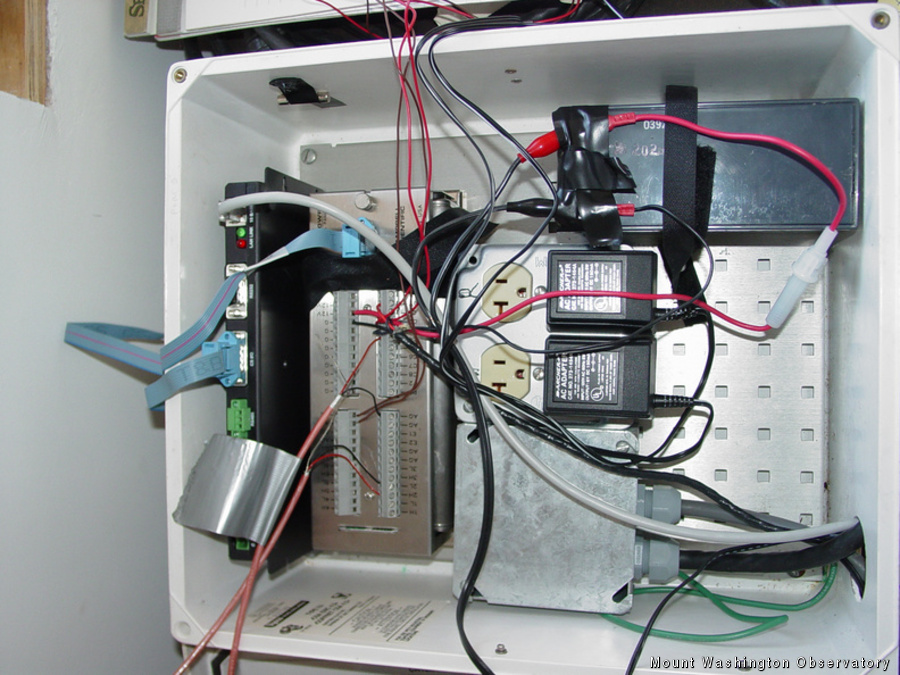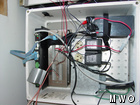Technology. Can’t live with it. Can’t live without it.
2012-10-12 18:12:24.000 – Brian Fitzgerald, Weather Observer/Education Specialist
Confused yet? So am I.
Up high at the Mount Washington Observatory we are surrounded by all forms of technology- some forms simple, while some forms are a bit more complex. The Observatory houses everything from radio antennas, microwave-link dishes, Polycom videoconferencing technology, digital barometers, anemometers to more low-tech items like mercury thermometers and mechanical barographs and wind charts. Given our isolated nature on the Rockpile it’s extremely important as Weather Observers that we know how to operate, and perhaps more importantly, fix instruments and technology when they break. After all, that’s half the reason why this station is still staffed and not simply an automated station like you might find at a small airport. You better believe that when the winds are ripping across the summit at 100mph and our wind vane freezes in place we need to be able to hop outside and fix it at a moments notice. The weather waits for no one, and frequently waits for the most inconvenient time to mess with an instrument.
While it’s impossible, and likely not very exciting for me to cover every instrument in the building, I’ll attempt to share a couple of items that are representative of the breadth of technology we have up on the summit. The first, and most complex that I will share is something known as a sonic anemometer. This instrument as you might imply from its name this is a wind measurement device that uses sound. How does this work you may ask? Well to get technical for a moment, this anemometer has three prongs of transducers on the bottom and top of the instrument through which ultrasonic sound waves are emitted and measured. As the wind flows through the device the time it takes for the sonic pulses will ultimately give us our data. Now this is also a 3D instrument which is able to give us not only wind speed, but wind direction and also the angle at which the wind hits the instrument. If you’ve spent any time on top of Mount Washington on a windy day you’ll note that winds normally travel up the side of the mountain at an angle far lower than most people are use to on flatter terrain. This instrument as you might imagine, does not come cheap and for that reason we typically only use this anemometer in nothing less than ideal conditions (no icing conditions allowed!).
One of the more famous and much less technical instruments the Observatory operates is something called a sling psychrometer. This instrument has been used since the very beginning of the observatory and has been used almost every single day since 80 years ago. The sling psychrometer is taken out by an observer whenever we are not in the clouds because the purpose of using this instrument is to find the current ambient air temperature and the wet bulb temperature. By finding these two numbers we can use a formula to calculate relative humidity which is a significant factor for forecasting precipitation events, fog, heat indices and helping folks understand how dry or sticky a day will be. As you can see in the image above, the sling psychrometer, two mercury thermometers attached to a sling. One thermometer is the dry bulb that measures the ambient air temperature and the second with the cotton swab on the bottom is the wet bulb which is soaked in water prior to being used. When the instrument in slung outside the wet bulb will read the current wet bulb temperature based on the evaporative cooling effect of slinging the instrument round and round. These two numbers have been recorded every hour on the hour since 1932 keeping our valuable 80 year climate record very consistent. This technology has been around long before I was born and likely will be used long after I’m gone in the hopes that this simple technology will ensure consistent and accurate weather observations.
If you are curious about more of our instruments and technology here at the Observatory I’d highly recommend checking out the free Weather Discovery Center in North Conway Village where you can link up live with the summit for more instrument and weather education or by visiting our website at MountWashington.org .
Brian Fitzgerald, Weather Observer/Education Specialist
Team Flags Return for Seek the Peak’s 25th Anniversary
Team Flags Return for Seek the Peak's 25th Anniversary By MWOBS Staff Mount Washington Observatory is looking forward to continuing a much-loved tradition for Seek the Peak’s 25th Anniversary: Team flags. In inviting teams
Meet Summer Interns Zakiya, Max and Maddie
Meet Summer Interns Zakiya, Max and Maddie By MWOBS Staff We are excited to welcome six teammates to the summit of Mount Washington this summer! During their internship, these students and graduates will play
Saying Goodbye to the Summit
Saying Goodbye to the Summit By Alexis George After an extraordinary last three years working as a Weather Observer and Meteorologist, I am excited to pursue a different career. As sad I as am






